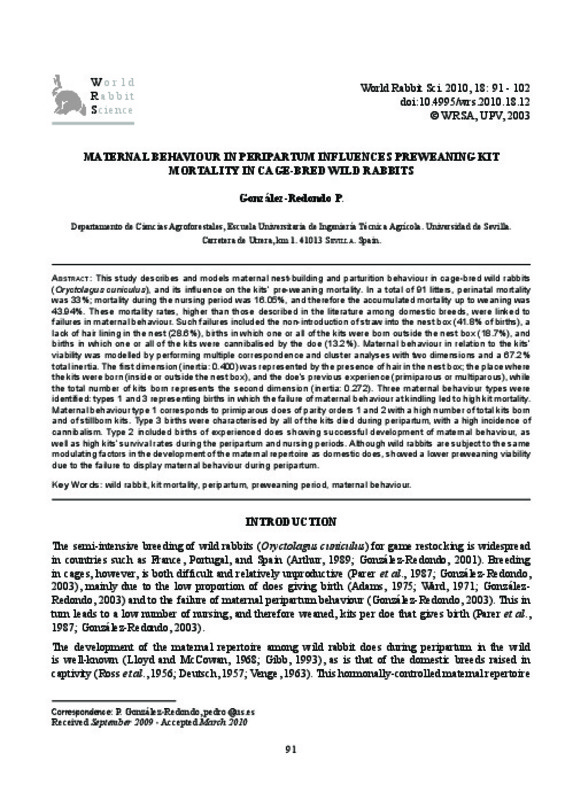JavaScript is disabled for your browser. Some features of this site may not work without it.
Buscar en RiuNet
Listar
Mi cuenta
Estadísticas
Ayuda RiuNet
Admin. UPV
Maternal behaviour in peripartum influences preweaning kit mortality in cage-bred wild rabbits
Mostrar el registro sencillo del ítem
Ficheros en el ítem
| dc.contributor.author | González-Redondo, P.
|
|
| dc.date.accessioned | 2010-07-15T10:44:40Z | |
| dc.date.available | 2010-07-15T10:44:40Z | |
| dc.date.issued | 2010 | |
| dc.identifier.issn | 1257-5011 | |
| dc.identifier.uri | http://hdl.handle.net/10251/8435 | |
| dc.description.abstract | This study describes and models maternal nest-building and parturition behaviour in cage-bred wild rabbits (oryctolagus cuniculus), and its influence on the kits' pre-weaning mortality. In a total of 91 litters, perinatal mortality was 33%; mortality during the nursing period was 16.05%, and therefore the accumulated mortality up to weaning was 43.94%. These mortality rates, higher than those described in the literature among domestic breeds, were linked to failures in maternal behaviour. Such failures included the non-introduction of straw into the nest box (41.8% of births), a lack of hair lining in the nest (28.6%), births in which one or all of the kits were born outside the nest box (18.7%), and births in which one or all of the kits were cannibalised by the doe (13.2%). Maternal behaviour in relation to the kits' viability was modelled by performing multiple correspondence and cluster analyses with two dimensions and a 67.2% total inertia. The first dimension (inertia: 0.400) was represented by the presence of hair in the nest box; the place where the kits were born (inside or outside the nest box), and the doe's previous experience (primiparous or multiparous), while the total number of kits born represents the second dimension (inertia: 0.272). Three maternal behaviour types were identified: types 1 and 3 representing births in which the failure of maternal behaviour at kindling led to high kit mortality. Maternal behaviour type 1 corresponds to primiparous does of parity orders 1 and 2 with a high number of total kits born and of stillborn kits. Type 3 births were characterised by all of the kits died during peripartum, with a high incidence of cannibalism. Type 2 included births of experienced does showing successful development of maternal behaviour, as well as high kits' survival rates during the peripartum and nursing periods. Although wild rabbits are subject to the same modulating factors in the development of the maternal repertoire as domestic does, showed a lower preweaning viability due to the failure to display maternal behaviour during peripartum | en_EN |
| dc.language | Inglés | en_EN |
| dc.publisher | World Rabbit Science. ICTA. UPV | en_EN |
| dc.relation.ispartof | World Rabbit Science | |
| dc.rights | Reserva de todos los derechos | es_ES |
| dc.subject | Maternal behaviour | en_EN |
| dc.subject | Preweaning period | en_EN |
| dc.subject | Peripartum | en_EN |
| dc.subject | Kit mortality | en_EN |
| dc.subject | Wild rabbit | en_EN |
| dc.title | Maternal behaviour in peripartum influences preweaning kit mortality in cage-bred wild rabbits | en_EN |
| dc.type | Artículo | en_EN |
| dc.identifier.doi | 10.4995/WRS.2010.18.12 | en_EN |
| dc.rights.accessRights | Abierto | es_ES |
| dc.description.bibliographicCitation | González-Redondo, P. (2010). Maternal behaviour in peripartum influences preweaning kit mortality in cage-bred wild rabbits. World Rabbit Science. 18(2). https://doi.org/10.4995/WRS.2010.18.12 | es_ES |
| dc.relation.publisherversion | https://doi.org/10.4995/WRS.2010.18.12 | es_ES |
| dc.description.volume | 18 | |
| dc.description.issue | 2 | |
| dc.identifier.eissn | 1989-8886 | es_ES |








